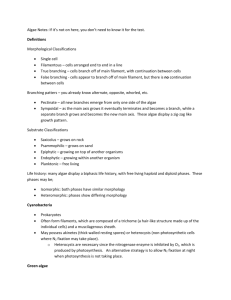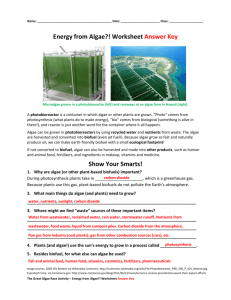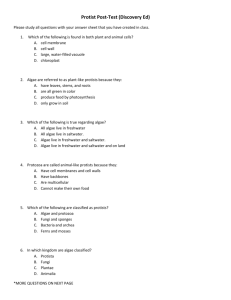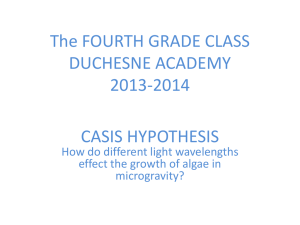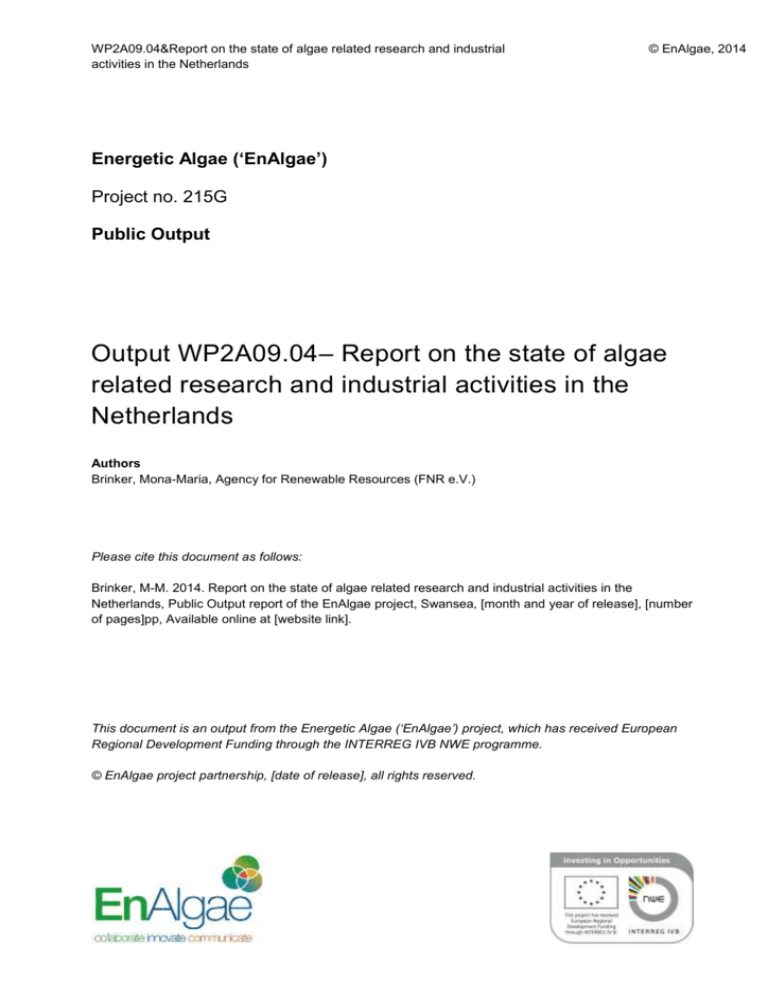
WP2A09.04&Report on the state of algae related research and industrial
activities in the Netherlands
© EnAlgae, 2014
Energetic Algae (‘EnAlgae’)
Project no. 215G
Public Output
Output WP2A09.04– Report on the state of algae
related research and industrial activities in the
Netherlands
Authors
Brinker, Mona-Maria, Agency for Renewable Resources (FNR e.V.)
Please cite this document as follows:
Brinker, M-M. 2014. Report on the state of algae related research and industrial activities in the
Netherlands, Public Output report of the EnAlgae project, Swansea, [month and year of release], [number
of pages]pp, Available online at [website link].
This document is an output from the Energetic Algae (‘EnAlgae’) project, which has received European
Regional Development Funding through the INTERREG IVB NWE programme.
© EnAlgae project partnership, [date of release], all rights reserved.
Report on the state of algae related research and
industrial activities in the Netherlands
Contents
1
Introduction ......................................................................................................................................... 2
2
Dutch stakeholders ............................................................................................................................ 3
3
Types of algae ................................................................................................................................... 10
4
Cultivation facilities .......................................................................................................................... 12
5
Growth conditions ............................................................................................................................ 14
6
Markets .............................................................................................................................................. 16
7
Underpinning activities and environmental impacts .................................................................... 18
1 Introduction
In 2012-2014 an inventory of North-West European algae initiatives was carried out to provide an
impression of research and commercial activities connected to algae production and utilization. The
collected data has been reviewed in country specific reports and collated and summarised in an overview
report covering the whole North-West-Europe region (including Great Britain, Ireland, Germany Belgium,
France, Switzerland, Luxemburg and the Netherlands).
Data was obtained via a comprehensive questionnairewhich was distributed among stakeholders
identified in a preliminary scoping exercise. Although not unexpected, unfortunately not all questionnaires
were returned. In these cases, publically available information was used for the landscaping study and
some additional information was collected through personal interviews with the respective stakeholders.
The questionnaire aimed to gather more information on focus, expertise and applied technology of the
addressed institutions. It was also designed in a way that as allows its use as an information sheet in
EnAlgae’s web-based information portal.
This report summarises the results of the analysis of data collected in the Netherlands, where 40 % of the
sent-out questionnaires were returned by the stakeholders. For the purpose of clarity, the following
analysis has been differentiated between research institution and industry.
In this context it must be emphasized that this report cannot claim to reflect an exhaustive list of all
stakeholders active in algae research and business. The reasons behind this are:
It is a rather broad area and in some cases only very limited information is available about respective
activities. In addition, there is lots of movement in this sector with regard to new start-ups and the closing
down of business operations, making it difficult to give an up-to-date overview. If too little information
could be found about certain institutions they were not included in this survey.
However, this study nevertheless represents the most important institutions active in this area, allowing
conclusions to be drawn about the main fields of interests, technology and market opportunities for algal
research in the Netherlands.
2
2 Dutch stakeholders
In total 51 institutions working with algae could be identified in the Netherlands. The majority of these
stakeholders (65 %) are commercial algae stakeholders. The other stakeholders are from research
institutions. It needs to be noted that most commercial algae stakeholders are also carrying out algae
research and vice versa. This separation into the different types of stakeholders is based on the
organization type of the organization mainly. Two regional water boards were also included in the
research sector as they are not profit oriented as the commercial stakeholders. The following table
(table 1) gives an overview about the identified stakeholders, sub-divided into commercially active
representatives and academic research oriented stakeholders.
Table 1: Overview of Dutch stakeholders active in the broader algae area
Commercial stakeholders
AkzoNobel
Algae Food & Fuel
Algaecom
Algaelink
AlgaSpring
AkzoNobel is the largest global paints and coatings company and is a
leading producer of specialty chemicals. AkzoNobel is involved in the
Algicoat project, hosting the demonstration units in Delfzijl since
September 2008.
Algae Food & Fuel designs, builds, sells and installs systems for the
industrial and agricultural production of algae: algae farming. The use of
innovative technologies for algae growth, process control and harvesting
results in unique scalable systems which are cost efficient, highly
productive and improve the stability of algae based processes.
Algaecom develops algae production sites. Cost and quality are
Algaecoms key values. Therefore production is within the credentials of
GMP+, HACCP and where possible under the SKAL label for biological
products. These quality criteria are combined with robust yet affordable
technology, so that our algae can be offered at a competitive price. The
ambition of Algaecom is to operate production sites of 2 to 5 hectares,
using residual heat and CO2 from flue gases produced by host companies.
AlgaeLink is a global leader in algae technology for 1. Pharma, 2. Food, 3.
Feed, 4.Fuel, 5.CO2 sequestration and 6. Waste water treatment
applications. A diversified range of 50 international projects has created
the largest global network of algae cultivation projects. The fully
automated AlgaeLink technology platform enables information exchange
and fast learning curves.
AlgaSpring is a micro-algae biotech company focusing on nutrition,
personal care and water treatment. AlgaSpring cooperates with
specialized companies in feed, food and personal care for the
development of products and sales.
Aquaphyto
AquaPhyto BV is an innovative company specialized in large scale
production of micro-algal biomass. At Schiphol Airport, AquaPhyto owns
an algae production unit for waste water treatment. Demonstration pond
used to produce algae cultures for customers or for in-company research
Bioclear B.V.
To create innovative solutions that makes the world more sustainable
using the power of nature: that is what Bioclear stands for. Bioclears aim
is to construct a 10 acre pilot farm in the Eemshaven to create a unique
possibility for hands on experience in the large-scale cultivation of microalgae and other aquatic biomass like duckweed or Azolla. A business
3
Crassus
B.V.
Advice4You
CreemersBioEnergie
DSM
Essent
Evodos
Fargate
Hortimare
case is constructed utilizing power of scale, utilizing industrial waste
streams (water, CO2, heat, nutrients) and by selling the protein-rich algae
as feed. Bioclear is involved in the BioSolar cells project for which it codevelops techniques for maximum valorization of PUFA rich algae
together with the University of Groningen and Algaecom
Crassus Advice4You helps companies to determine, develop and realize
bio technology and innovative projects. Crassus Advice4You is involved in
several national and international projects on algae growing on waste
streams and algae coordinated along with biogas production units.
Crassus is involved in the planning stages of these projects.
The CBE (CreemersBioEnergie) companies are founded in 2008 with the
aim of producing algae and processing algae to various green energy
flows on a farm.
DSM is a life sciences company focusing on health, nutrition and
materials. DSM is involved in the joint research project BioSolar Cells.
DSM want to get insight in (im)possibilities of phototrophic algae. DSM
sells Life’s DHA™ - a fish free, sustainable source of DHA omega- 3 from
algae that provides important brain, eye and heart benefits throughout life
and can be found in over 500 foods, beverages, infant formulas and
supplements worldwide.
Essent is the Netherland's largest energy company. It was involved in the
Algicoat project (Coating Components firing the Economic Biorefinery of
Algae). Essent'stask in the project were to research the energy and CO2
aspects of the algae production, the conversion into biodiesel of the
extracted biomass as well as other side streams (heat/electricity).
Evodos is a company who specialized in separation technologies. Evodos
has excellent results in harvesting algae.
Fargate offers a concept to improve the sustainability profile of its
customers by making use of their waste streams and reducing their
emission. This evolved into the idea of making use of the waste streams
warm water and CO2 as ingredients for producing algae. As production of
algae is not the core business of its customers, they contacted algaeusing companies to develop a market aligned with the specific needs and
their preferred types of algae. Basically Fargate has three activities to
organize for its business:
•Developing and selling installations
•Trading in algae
•Servicing the total business: e.g. maintenance
Hortimare is propagating seaweed for a sustainable future. Hortimare is
involved in growing and cultivating seaweed. Hortimare has the vision to
enhance the opportunities for the cultivation of seaweeds and offers high
quality starting material. Various types of seaweed as young plants are
available for experiments and commercial production. Hortimare delivers
the fertilized gametophytes that just developed a small seaweed plant.
This is attached to a carrier of choice so that it can be brought to grow in a
tank or at the high sea.
4
ICOPAL
Icopal is Europe's leading manufacturer of products for the protection and
waterproofing of building structures, particularly roofing and waterproofing
membranes. Icopal has an algae pilot plant for the recycling of CO 2 from a
bitumen factory.
Kelstein
Kelstein is a company where three companies are linked with each other.
The companies are dealing with dairy, biogas and algae growing.
This results in a closed chain of various streams: »Dairy farm »Biogas
»Algae Cultivation working together in an innovative way to utilize
residues that are common in farms. There has been developed a chain
method in which the waste products used as raw material for the
production of high biomass in the form of algae.
Lans is a commercial tomato producer. Lans is involved in the research
project "algae cultivation in horticulture" to make use of the synergies
between plant and algae production in greenhouses.
LansTomaten
LGem B.V.
Maris Projects B.V.
LGem is an innovating company, active in the algae industry since 2005.
The company’s motto: “LGem creates gems from light” easily explains the
name of the company. In the early days LGem was founded on a propriety
technology. In 2007 LGem started with a commercial scale production and
sales of Nannochloropsis. This allowed them to validate and further
improve their technology at a commercial scale. These valuable years of
practical experience resulted in the development of GemTube systems
equipped with the unique and patented Wavywind and Bubblebrush
process. GemTubes ranging from 250—18,000 litres are now
commercially available. The modular set up gives great flexibility in
customizing unit sizes and dimensions, to client demands.
GemTubes are available for any need!
The key activities from Maris Projects B.V. are processing waste to valued
products. This has been Maris projects B.V. key activities for a long
period. In the last years they gained experience especially in waste to biofuel and sub-products process. Maris Projects B.V. sells algae technology
and grows algae.
Paques B.V.
Paques is a company focusing on biological wastewater and gas
treatment. Paques is involved in the research project SPLASH and in the
Algae Parc. Paques designs and builds various photobioreactors for
microalgae production
Phycom
Phycom manufactures and markets essential nutrients for food, feed and
pharma based on algae. Phycom selects the best algae strains and is
able to make them axenic before cultivation starts. After succeeding the
cultivation step, mass volume production of whole algae strains starts.
This is realized by Phycom's algae production technology, which means
production under the highest hygienic standards compliant with ISO
22000.
5
Phytocare
Phytocare is consulting company. They were involved in the algae
research project "Algae cultivation systems for horticulture". Nowadays
Phytocare consult Ecoferm.
Plankton Solutions
Focus on algae production on large scale.
Port of Rotterdam
The Port of Rotterdam’s focus in algae is on floating infrastructures due to
a specific demand that the water level rises continuously during the
operation of the Slufter (primarily used as a contaminated dredge-sludge
landfill). Ultimately 260 ha will be available for algae farming. This is the
single largest planned area for algae cultivation in the Netherlands.
PROCES-Groningen
BV
Proces Groningen is involved in seaweed biorefinery; they have several
projects on digesting micro-algae.
ProductschapTuinbou
w
ProductschapTuinbow leads a project on "algae for horticulture".
RFE Renewable Fuel
& Energy
RFE Renewable Fuel & Energy’s objective is developing, producing and
trading of renewable fuel and energy, included import and export. RFE is
also constructing a pilot project for the production of algae that are used in
food and feed.
Roem van Yerseke
Roem van Yerseke has a wide range of shellfish, where in mussels,
oysters and prawn play a central role. In addition to these core products,
they also offer supplement products to complete the product scope. The
nutrition of shellfish broodstock, larvae and spat, consists of several types
of micro-algae. These algae are cultivated in a specially conditioned area.
Roem van Yserke provides possibilities to purchase living micro-algae.
Royal HaskoningDHV
The company, headquartered in Amersfoort, the Netherlands, is one of
Europe's leading project management, engineering and consultancy
service providers, ranking globally in the top 10 of independently owned,
non-listed companies and top 40 overall. Royal HaskoningDHV has more
than 10 years of experience with the cultivation of algae and a lot of
experience and expertise in waste water treatment are being combined in
the HRAP system (also called Integrated Algae Pond Systems IAPS).
Van der Lans
Van der Lans is an independent importer and distributor of fresh fruit and
vegetables. A pilot system in which the growth of algae is tested as an
extra income for tomato growers, freely available space beneath tomato
gutters is used to place the reactor.
ViskwekerijNeeltjeJans
A seafood producer (mussels). Algae are cultivated as feed source for
mussels.
6
Waterstromen B.V.
Waterstromen B.V. is a waste water treatment company, focusing on
water self-purification, including algae usage.
Wetsus
Wetsus, centre of excellence for sustainable water technology is a
facilitating intermediary for trend-setting know-how development. Wetsus
creates a unique environment and strategic cooperation for development
of profitable and sustainable state of the art water treatment technology.
Wetsus participates in several research projects dealing with algae, e.g.
on the maximization of photosynthetic efficiency; on algal biofilms; on the
optimization of lipid production in microalgae and on carbon dioxide
supply in photobioreactors.
Scientific Stakeholders
ECN
ECN is the largest energy research institute in the Netherlands. ECN is
participating in two research projects cultivating seaweed in the North
Sea.
Hoogheemraadschap
HollandsNoorderkwarti
er
The regional water board (HoogheemraadschapHollandsNoorderkwartier
– HHNK) is a government body with its own democratically elected
management board and independent tax system. A pilot study on the
wastewater treatment plant (RZWI) Alkmaar was carried out in order to
develop knowledge about the performance of algae in an open reactor
under Dutch climate conditions.
NIOZ
Royal
Netherlands Institute
for Sea Research
NIOZ Royal Netherlands Institute for Sea Research is the National
Oceanographic Institution of the Netherlands. The mission of NIOZ is to
gain and communicate scientific knowledge on seas and oceans for the
understanding and sustainability of our planet, and to facilitate and
support marine research and education in The Netherlands and Europe.
The department of marine microbiology investigates the origin and
maintenance of microbial diversity and its role in the structure and function
of marine ecosystems. They are involved in the research project
InteSusAl, they also do research on the photobiology of pelagic and
benthic microalgae and on the isolation, identification, cultivation, and
preservation of microalgae.
Rijksuniversiteit
Groningen,
Ocean
Ecosystems - Energy
and
Sustainability
Research
Institute
Groningen (Faculty of
Mathmatics
and
Natural Sciences)
Reijksuniversiteit
Groningen,
Plant
Ecophysiology
- Centre for Ecological
and
Evolutionary
The department of Ocean Ecosystems is carrying out a research project
on algae for green chemicals: physiology and growth optimization of
marine diatoms for production of Long Chain Poly Unsaturated Fatty Acids
The department of Plant Ecophysiology studies the interaction between
plant and environment. The adaptive and stress responses of plants to
changes in the environment can be molecular, biochemical, biophysical,
physiological and/or developmental modifications. The analysis of plant
responses from the molecular level up to the level of the intact plant
7
Studies(Faculty
of
Mathematics
and
Natural Sciences)
StichtingZeeschelp Research Institute for
marine aquaculture
Stowa - Foundation for
Applied
Water
Research
TNO (Dutch institute
for applied sciences)
Technical University
Delft, Faculty of
Applied Sciences
Technical University
Eindhoven Department of
mechanical
engineering
University of Twente The green energy
initiative
VrijeUniversiteit
Amsterdam - Faculty
of Sciences Biophysics of
Phoyosynthesis/Energ
y
Wageningen
University and
Research Centre ACCRES
allows a fully integrated understanding of the plant-environment
interaction. In the past 7 years the responses to light, salinity, drought, air
pollution, elevated CO2, UV, sulfur and nitrogen nutrition and the effect of
temperature have been studied in integrated projects. One focus lies on
the utilization of carbon by aquatic algae and plants.
StichtingZeeschelp focuses on stimulating innovation in marine
aquaculture. They are conducting their own research and provide facilities
for research at the station for marine aquaculture. The focus of
StichtingZeeschelp lies with marine aquaculture and marine ecology.
The foundation coordinates and commissions research on behalf of a
large number of local water administrations. The bodies which contribute
to the STOWA are the 26 water boards, the provinces and the Ministry of
Transport, Public Works and Water Management. Stowa has been
investigating effluent polishing with algae.
TNO is running an industrial consortium, named GAIA, together with algae
producers and end-users of algae ingredients to focus on processing of
algae biomass and make the application of algae ingredients feasible.
TNO has important know-how in opening algae and separating ingredients
like proteins, oil and carbohydrates energy-effectively on a lab scale. This
know-how will be used for scaling up to an industrial pilot. Furthermore, a
mobile algae biorefinery will be fully operational in Q2 2014.
TU Delft scientists are researching how to grow ‘fat’ algae by creating an
environment in which they have an advantage over other kinds. These
surviving ‘fat’ algae store a high percentage of lipids that are extracted to
create biofuels
The department of mechanical engineering of the Technical University
Eindhoven is developing a lab-on-a-chip that functions as a compact
robust tool for the fast screening, real-time monitoring, and initial
classification of algae.
The green energy initiative of the University of Twente is involved in a
project called Be2.0 in which (among others) joint research with WUR on
fuel from algae. While WUR is working on the algae selection and growth,
U Twente is working on developing a method to produce ‘algae-fuel’ on a
large scale.
The group has a long tradition in photosynthesis research. Presently,
there is a strong and coherent focus on Solar Fuels, to be created in
systems ranging from genetically engineered organisms and
artificial/hybrids photosynthetic complexes.
ACRRES is an acronym for Application Centre for Renewable REsources
and is the national applied research centre for sustainable energy and
green raw materials. The applied research centre is a joint effort of the
Lelystad research institutes Applied Plant Research and the Animal
Sciences Group, both part of Wageningen UR, and ENECO. ACRRES
investigates the possibilities of algae as a new (agricultural) crop and also
8
considers biorefinery of algae biomass, which occurs as a component in a
number of projects.
Wageningen
University
and
Research Centre AlgaePARC
Wageningen
University
and
Research Centre Bioprocess
Engineering
Wageningen
University
and
Research Centre Food and Biobased
products
Wageningen
University
and
Research Centre IMARES
WetterskipFryslan
Friesland
Water
Authority
Wageningen University and Research Centre (WUR) has built
AlgaePARC pilot facilities at the Wageningen Campus. The goal of
AlgaePARC is to fill the gap between fundamental research on algae and
full-scale algae production facilities. This will be done by setting up flexible
pilot scale facilities to perform applied research and obtain direct practical
experience. It is a joined initiative of BioProcess Engineering
(Wageningen University) and Food & Biobased Research. The research
themes vary from microalgae strain development to microalgae cultivation,
microalgae biorefinery and microalgae products.
The Bioprocess Engineering Chair group teaches and develops new biobased processes for production and bio-refinery of pharmaceuticals,
healthy food ingredients, bulk chemicals and biofuels. The depratement is
involved in the research projects "Algae Parc", "biosolar cells", "Fuel4Me",
"Splash", "Algadisc" and many other algae research projects (both microand macro-algae).
Food & Biobased Research is part of Wageningen University & Research
centre. Food & Biobased Research is involved in the production and
harvesting of micro-algae as well as the development of algae-specific
biorefinery technologies. Food & Biobased Research focuses on
biorefinery concepts which use the entire crop and extract both proteins
and sugars from seaweed, for instance. New biorefinery concepts for
microalga e and seaweed are a current research topic at Food &
Biobased Research.
It is involved in a research project on seaweed as source of biofuels and
chemicals. A close cooperation with WURs AlgaePARC is given.
Imares is one of the research institutes of the Wageningen University.
IMARES (Institute for Marine Resources and Ecosystem Studies) is the
Netherlands research institute established to provide the scientific support
that is essential for developing policies and innovation in respect of the
marine environment, fishery activities, aquaculture and the maritime
sector. At IMARES a report was conducted on the feasibility of sustainable
offshore production of seaweed. IMARES also offers indoor and outdoor
cultivation of algae.
Friesland Water Authority is a regional water board in the Netherlands.
WetterskipFryslân is responsible for integrated water management in the
province of Fryslân as well as a small part in the province of Groningen.
9
3 Types of algae
The majority of the stakeholders are working with microalgae. A relatively small proportion is cultivating
and processing macroalgae or working on both macro and micro types (13 % of the industrial
stakeholders and 38 % of the research institutions).
35 % of the concerned stakeholders provided information about the precise algae specie(s) they are
using. The majority of these stakeholders are using green algae (59 %, figure 1). Overall, the most
favoured species are Chlorella sp., Scenedesmus sp., Nannochloropsisgaditana and Phaeodactylum sp.
(figure 2).
5 % of the Dutch stakeholders work with cyanobacteria. Although cyanobacteria are not algae from a
scientific perspective, they are often mentioned in the context of micro-algal activities. Some of the
stakeholders have focused on both microalgae and cyanobacteria. For this reason the work with
cyanobacteria was also included in this overview.
Various species of macroalgae such as Laminaria, Alariaesculenta and Latissimasaccharina, account for
7 % of algae species under investigation in the Netherlands.
Figure 1: Used algae types in the Netherlands
10
Figure 2: Number of institutions working with these algae species (multiple answers permitted)
11
4 Cultivation facilities
Over the last decade, constant and innovative research and development has been taking place in the
area of algae cultivation technology. The presently used cultivation systems can be subdivided into
following systems:
Table 2: Cultivation systems
Open/ Half-open production systems
Open-Ponds
Race-Way-Ponds
Longlines
Closedphotobioreactorsystems (PBR)
Flat bed/ Plate/ Flat panel reactor
Tubular reactor
Bag/ Flexible tube reactor
Rain creating stack system („Horizon“)
Fermentation
vessel
(heterotrophiccultivation)
Closed cultivation systems have the advantage of better controlling the cultivation conditions and,
consequently, to guarantee the best temperature and light regime under almost sterile conditions.
Raceway ponds are the most favoured facilities for cultivating microalgae in both, industry and academia
in the Netherlands. The most common closed photobioreator systems used in both commercial as well as
research oriented institutions are tubular photobioreactors followed by plastic bags (figure 2 and figure 4).
Many stakeholders run more than just one type of PBR.
Six of the research institutions and two of the commercial algae stakeholders have mentioned that they
use “other” algae cultivation facilities. Those “other” algae cultivation facilities are often mentioned to be
open ponds, LED photobioreactors or small scale laboratory flasks.
12
Figure 3: Cultivation facilities at research institutions
In regard to size of the facilities there are big differences between the different stakeholders. Some of the
industrially used algae growth facilities comprise a volume of over 2500 m³, whereas some of the
research institutions use facilities with less than 1 m³ capacity. It can be noted that generally the
commercial algae producers have the bigger algae production facilities.
Figure 4: Cultivation facilities in industry
13
5 Growth conditions
Approximately two-thirds of the Dutch algae stakeholders provided information about the conditions in
their respective algae growth facilities. In respect to growth conditions, the survey did not go into too
much detail, but rather concentrated on the origin of the three main substances: water, light and carbon
dioxide. Multiple answers were possible.
Figure 6: Growth condition - water
In regard to the growth medium, most of the stakeholders concentrate solely on either salt or fresh water
species, the usage of both fresh and salt water for the cultivation of algae is only carried out at 10 % of
the stakeholders. The use of fresh water slightly predominates when stakeholders are only focusing on
one of the two mediums (figure 6).
Nearly a quarter of the stakeholders use waste water for algae cultivation. The waste water sources are
not named too often but comprise effluents from biogas plants and agricultural wastewaters.
14
Figure 7: Growth condition - light
In terms of the light regime, the majority of the stakeholders, who provided respective information, use
natural light for growing algae: 37 % solely rely on the natural radiation whereas 19 % of the stakeholders
use artificial light when necessary (figure 7). Only 11 % of the stakeholders exclusively use artificial light
for their algae cultivation. Only 2 % of the stakeholders have (also) focused on heterotrophic microalgae
production and do not use any light.
Figure 8: Growth conditions – CO2 supply
As for the carbon dioxide supply, most of the stakeholders are using industrially bottled CO 2 or fossil
based CO2 (both 18 %, figure 8). The stakeholders using fossil based CO 2 have often installed their algae
cultivation facilities close to heat or combined heat and power plants (CHP) and use the fossil based flue
gas for algae production as a side product.
15
Renewable carbon dioxide is mostly used when algae production is combined with a biogas plant in
which CO2 is produced as side product. In one case the flue gas from a heat plant based on wood is
used. Altogether 10 % of the questioned stakeholders use CO 2 from renewable resources.
6 Markets
As in the section on algal cultivation conditions, it needs to be emphasized that multiple answers were
permitted since most algae stakeholders aim for more than one single product respectively market sector.
The results have been summarized in the bar charts figure 9 and 10. In order to determine the most
promising market sectors for algae, the targeted products have also been grouped accordingly.
The markets for feed, energy and bioremediation are the most important targets for all Dutch
stakeholders. Specialty chemicals and other commodity products also seem to play a bigger role,
whereas the food sector and the production and design of photobioreactors seem to be of lesser
importance to the Dutch algae stakeholders in general (figure 9).
Figure 9: Broad overview of targeted markets of the Dutch algae stakeholders
When breaking the information down on the research versus commercial stakeholders (figure 10), and
into the more precise target products, it is obvious that the most important markets for the commercial
algae sector in the Netherlands are the feed sector (both for livestock and aquaculture) as well as
wastewater remediation. In the total overview on the targeted markets, it seems that the design and
production of photobioreactors is of little importance (figure 8). For the commercial algae sector though,
the design and production of photobioreactors is of big importance, the research sector though does not
focus much on it (figure 9).
16
Figure 9: Targeted markets of Dutch algae stakeholders (x-axis= number of institutions targeting the
specific market)
Beside typical biofuel products like biogas, oil, bioethanol, biodiesel and kerosene, some research
institutions further examine alternative energy products like hydrogen (figure 9). This offers promising
approaches, but seems currently to be still too far from the market. Consequently, these pathways are
mainly further developed in the context of research projects and are not yet pursued by commercial
stakeholders.
In comparison with the research sector, bioenergy is as an important product for industrial stakeholders in
the Netherlands.
17
7 Underpinning activities and environmental impacts
Besides their main focus of activity, most of the stakeholders are also involved in actions supporting their
efforts in further developing and improving their targeted products. About 72 % of the research
stakeholders and 37 % of the commercial algae stakeholders in the Netherlands provided information
about these underpinning activities.
The majority of industrial stakeholders (47 % in total; figure 10) are investigating in new or further
developing approaches for harvesting and processing algae biomass. R&D on processing technology is
also the main interest of the research institutions with 50 % of the research stakeholders involved. A
further 33 % of research institutions and 16 % of commercial stakeholders carry out “other” underpinning
activities, involving activities such as R&D on production technologies, recirculation techniques or genetic
engineering of algae.
Figure 10: Number of stakeholders (in %) involved in following underpinning activities (multiple answers
possible)
18
Figure 11: Number of stakeholders (in %) involved in research on environmental impacts (multiple
answers were permitted)
Only 28 % of the research stakeholders and 16 % of the commercial stakeholders in the Netherlands are
involved in research on environmental impacts.
Out of these few percent several of the stakeholders were dealing with different research on
environmental impacts of algae production. The research institutions are mostly active in the LCA of the
algae production and abiotic interaction, whereas the commercial interests on the research on
environmental impacts are broader. LCA is also domination as activities of the commercial stakeholders,
but the other aspects in this field seems to be of importance to the commercial stakeholders as well
(figure 11).
19





